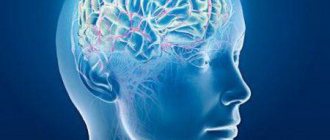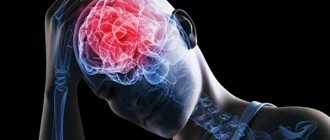Finite brain
The youngest section of the brain is the terminal section.
It is a fairly massive department of the central nervous system and is the most developed. The telencephalon covers all sections and consists of:
- Cerebral hemispheres;
- Plexus of nerve fibers (corpus callosum);
- Alternating stripes of gray and white matter (striatum);
- Structures associated with smell (olfactory brain).
In the cavity of the terminal part of the organ there are lateral ventricles, represented in each hemisphere (conventionally considered right and left).
Functions of the final department:
- Movement regulation;
- Reproduction of sounds (speech);
- Skin sensitivity;
- Auditory and taste sensations, smell.
The longitudinal fissure separates the left and right hemispheres; the corpus callosum (plate of white matter) is located deep in the fissure. In the thickness of the white matter there are the basal ganglia, which are responsible for transmitting information from one section to another and perform basic functions.
The hemispheres control and are responsible for the work of the opposite side of the body (the right half for the left half and vice versa). The left hemisphere of the brain is responsible for memory, thought processes and individual talents in humans.
The right hemisphere of the brain is responsible for processing various information and imagination, which is also generated in dreams. All parts of the brain and the functions they perform are a joint work of the two hemispheres and the cortex.
In each person, one part of the organ is dominant, either the right or the left - which hemisphere is more active depends on individual characteristics.
The coherence of all brain structures allows you to perform all functions harmoniously and maintain balance throughout the body. The functioning of each part of the central nervous system organ is quite well studied, but the functionality of the brain as a single mechanism is described superficially and requires more in-depth scientific research.
Theta waves
The phenomenon called theta brain waves allows a person to experience a deep sense of relaxation at a frequency of 4 to 7 hertz. It manifests itself between sleep and the onset of dreams, as well as in the deep sleep phase, when there are no dreams. Also, the manifestation of such waves can cause states of hypnosis or high-quality meditation. They can be compared to playing the cello. The cause of the strong activity of such waves is considered to be the lymphatic system.
Often, theta brain waves occur even outside the sleep phase. For example, in an extremely calm state, when you need to remember something or fantasize. The activity of these waves connects the subconscious with consciousness, opening access to information that is impossible to obtain in normal everyday life. A person may experience peculiar visions. The images will be dark, but clear and very meaningful. You can activate theta rhythms through meditation.
With a normal amount of theta waves, a person appears calm and peaceful. But any negative emotions reduce their activity. With sufficient quality training, you can learn to switch yourself from regular waves to theta. It will also increase your concentration and level of connection between your brain and body.
People who live with a predominance of electromagnetic impulses of the theta rhythm have a number of advantages. Among them:
- good memory,
- developed creativity,
- creative thinking,
- high spirituality,
- quick understanding of associations.
As a rule, the manifestation of such waves is observed in children under 13 years of age, because they are subject to their overabundance. And in adults, in 99% of cases, the work of such waves occurs only at night.
Theta brain rhythm - relaxed state
The theta rhythm of the brain is recorded:
- in a relaxed state, in light sleep with dreams
- deep meditation
- in the process of accelerated learning and in healing.
Brain vibrations become slower and more rhythmic. The action of defense mechanisms decreases, which makes it possible for information to penetrate deep into the subconscious, and liberation from suppressed emotions and mental blocks occurs. It is the twilight state between sleep and wakefulness that allows access to the unconscious part of the mind. An analogue of the theta rhythm of the brain is the cello.
Theta is a waking dream, vivid images flash before the mind's eye, and sensitivity to information outside of ordinary consciousness increases. Provides access to free associations, unexpected insights, and creative ideas. This brain state has a name: hypnagogic. The theta rhythm of the brain allows you to see God in everything, recognize patterns and cycles. At this stage, revelations and prophetic dreams often come to us. In the Theta state, powerful shamans and enlightened Yogis create.
Hypnagogia is the state immediately preceding sleep. Hypnagogic states are usually characterized by the presence of images (visual, auditory, kinesthetic, etc.), but an almost complete absence of narrative.
Edison worked very hard on his inventions. When he reached a dead end, he would sit in a chair, take a metal ball in his hand, which he freely lowered along the chair, and fall asleep. Having fallen asleep, he involuntarily let go of the ball from his hand and the roar of the ball falling to the floor woke him up. Often this was accompanied by fresh ideas about the project he was working on. Salvador Dali spent his daytime sleep sitting in a chair, holding a spoon in his hand, but as soon as sleep overcame him, the spoon fell onto an iron tray on the floor. This ringing sharply awakened him, which allowed him to find new ideas. He borrowed this method of switching consciousness to a different brain rhythm from the Cestercian monks.
Images generated by Alpha waves:
- more distinct, clear and understandable
- boundaries are clearer
- colors are more varied
Images generated by Theta waves:
- darker and less clear
- carry deep meaning
- rise from the depths of consciousness.
These images are perceived as insight or a gift from above, sometimes they are surrounded by light. Their appearance is often accompanied by a feeling of some kind of knowledge, an understanding that this image suggests the right decision, that it touches something in the depths of your consciousness. It happens that before the appearance of images of Theta waves, a person sees blue and violet waves. This indicates the activation of strong Theta waves.
In most modern people, the activity of Theta and Alpha waves is reduced. With the help of coffee, they wake up from deep sleep - Delta and push themselves into a state of active wakefulness - Beta. Working all day in the Beta range, in the evening they fall into deep sleep - a rough switch of the brain from Beta to Delta occurs. The brain is not given the opportunity to work at the frequencies of the soul - Alpha and Theta brain rhythms. Stimulants (coffee, etc.) - suppress Theta and Alpha waves, increasing the proportion of Beta waves, which is comparable to strained and hysterical singing.
Gamma waves, brain storage
Have a frequency greater than 36 Hz.
These waves are generated by the brain in all areas. In other words, they can be detected in all areas of the brain. It is generally accepted that when a person searches for information from different “storages” of the brain, the brain itself is in a state of generating gamma waves. A good memory indicator is associated with the generation of waves with a frequency of about 40 Hz.
An insufficient number of them can lead to a significant decrease in memory. The effects that arise from the deliberate invocation of gamma wave states have not yet been voiced in any way in official scientific sources. For this reason, it is difficult to say anything more specific and even more objective.
Sources
Remnant of a supernova explosion in ultra-high energy gamma rays
The image was taken in 2005 by the HESS gamma-ray telescope. It confirmed that supernova remnants serve as sources of cosmic rays - energetic charged particles that, interacting with matter, generate gamma radiation (see Diagram of gamma radiation generation). The acceleration of particles is apparently provided by the powerful electromagnetic field of a compact object - a neutron star, which is formed at the site of an exploding supernova.
Gamma radiation generation circuit
Collisions of energetic charged cosmic ray particles with atomic nuclei in the interstellar medium generate cascades of other particles, as well as gamma rays. This process is analogous to the cascades of particles in the Earth's atmosphere that occur under the influence of cosmic rays (see Diagram of a telescope for ultra-high energy gamma rays). The origin of the highest energy cosmic rays is still being studied, but there is already evidence that they can be generated in supernova remnants.
Accretion disk around a supermassive black hole (artist's drawing)
During the evolution of large galaxies, supermassive black holes are formed in their centers, weighing from several million to billions of solar masses. They grow due to the accretion (fall) of interstellar matter and even entire stars onto the black hole.
During intense accretion, a rapidly rotating disk is formed around a black hole (due to the conservation of the angular momentum of the matter falling onto the hole). Due to the viscous friction of the layers rotating at different speeds, it heats up all the time and begins to emit in the X-ray range.
During accretion, part of the matter can be ejected in the form of jets along the axis of the rotating disk. This mechanism ensures the activity of galactic nuclei and quasars. There is also a black hole at the core of our Galaxy (Milky Way). Currently, its activity is minimal, but according to some signs, about 300 years ago it was much higher.
Schumann resonance.
This resonance is the electromagnetic frequency of the Earth, which for a long time was equal to 7.8 Hz, which coincides with the Alpha rhythm of the human brain. The analogue is an orchestra, the instruments of which have merged into one quiet sound and an organ plays in the background.
The Schumann frequency is growing and today is 14 -15 Hz, corresponding to Beta - the rhythm of the brain, conscious activity. Because of this, most people experience dizziness, the brain is forced to work at ever-increasing frequencies.
Editor's note: Is an MRI procedure harmful?
With a further increase in frequency, the brain will reach 30 Hz or more, little studied
Gamma is the brain rhythm responsible for inspiration and creativity.
At this level, reason and reason are almost powerless; other mechanisms of perception and action operate here. It's like a superstructure over human consciousness. The frequency of brain vibration is 50 Hz, Zen - Buddhists call enlightenment. By increasing its frequency, the Earth thereby forces our brain to come out of hibernation and work more consciously. Each person intuitively has the ability to adjust his brain rhythm to the desired wavelength range. Or he does it consciously, knowing the adjustment mechanism.
Sound Frequency Chart for Musical Instruments from Sound On Sound
The sound frequency table consists of two parts. The first part is an Instrument Frequencies chart that provides information about the frequency ranges of a number of common musical instruments. Instruments are divided into five groups - human voice, percussion instruments, guitar and bass, strings, and wind instruments. Additionally, the diagram reflects the sound ranges of the given instruments, for which the illustration is supplemented with a list of octaves and the names and frequencies of the sounds included in them.
Sound frequency table. Screenshot of the first part.
The second part - “Subjective nature of sound” - is a table that shows the main frequencies for equalizing popular musical instruments, as well as comparative descriptions of these frequencies. The information in the table clearly shows how to make the sound of popular instruments sharper, sharper, clearer, or more intelligible.
At the same time, the creators note that they did not strive to create a comprehensive guide to equalization, but wanted to create a visual guide that would help musicians and sound engineers when recording and mixing music.
Sound frequency table. Screenshot.
The editors of SAMESOUND.RU translated and adapted the texts in the table, and also made a number of explanatory additions. The audio frequency chart is distributed as a PDF file that is ready to print in high resolution. The document contains cut margins and other information useful to printers. Note that it is better to print the table in A3 format, since when printing on A4 sheet, the legibility of the content is lost due to the abundance of small text.
Delta waves
The delta waves of the human brain are recorded at the lowest frequency. They can operate in a rhythm from 0.1 to 4 hertz. When neurons begin to emit such waves, people are in a state of trance or dreamless sleep. The rhythm can be compared to a light symphony
This type of waves is associated with a person’s involvement in some process when everything else does not interest him. It is believed that every child under one year of age constantly experiences a predominance of delta waves in the head. They help to navigate in space and time, make one anticipate various dangers, increase intuition, and develop instincts. As a rule, the presence of developed delta waves is observed in people engaged in research into human psychology and feelings, i.e. from psychotherapists.
This is the type of waves that allows you to establish a connection with the unconscious. To do this, you will need to overestimate the degree of their activity. When activated, a person’s consciousness turns off and is distracted from the outside world, and with good training, it will be possible to independently and consciously enter a state of trance. However, even with weak delta waves, a person may have problems concentrating on any task. To do this, you will need to weaken their effect by showing maximum activity.
Some people have a large amplitude of delta waves. They have very developed intuition. They can literally think a minute or second before an event that it will happen. This often happens to them, for example, before meeting an acquaintance or shortly before receiving a call on their mobile phone. They can also sense other people. This manifests itself both emotionally and physically. An excess of waves leads to problems. They manifest themselves psychologically. Waves of excessive brain activity of this frequency lead to the fact that a person receives too much information at an unconscious level. Also, people often feel guilty for someone else’s pain, which they suddenly begin to feel.
General information
Researchers have discovered waves in the brain that replace each other when the rhythm of activity changes. Most of them are frequency-locked to some type of thinking. They occur not only with maximum brain activity.
In humans, brain waves accompany any mental activity. There is no moment when the brain does not emit such impulses. In most cases, the brain does not generate any one frequency of waves, but emits several of them at once. But in each case, one type of wave dominates, and in certain situations, the frequency of waves created can be so pronounced that all other types of waves become insignificant.
Modern research shows that brain rhythms play a significant role in the manifestation of brain functions such as memory, attention or concentration. In an experiment by Earl Miller and Scott Brincat on monkeys, it was found that the frequency of the wave emitted by the brain changes depending on whether the monkey gave a correct or incorrect answer to a given problem
Such experiments are not uncommon, as the study of brain waves is now at its peak in neuroscience.
However, it is not just neuroscientists who are interested in the concept of brain waves. Electromagnetic brain waves are often used by numerous esotericists to substantiate their hypotheses. Despite the fact that the researchers did not find confirmation of most of them, the relationship between the frequency of a particular wave and specific images and thoughts was established. Due to the fact that there is little clear information at the moment, any advice on enhancing any type of brain waves should be taken critically.
From the editor: Human medulla oblongata
Classification of waves by frequency
Types of brain waves vary in frequency. Each frequency corresponds to a specific state of thinking: some waves accompany the active thought process, others are more pronounced during imagination or creative activity.
The assumption about the existence of waves of brain activity was put forward in Indian philosophical treatises, where they were divided according to the state of the brain at the moment of recording a particular rhythm:
- waking during the day;
- dreaming sleep;
- dreamless;
- a state of meditation, both deep and light.
However, in addition to these states, modern researchers have established some other frequency rhythms. Each of the waves was designated by a Greek letter. Let us consider in more detail their frequency and the conditions in which one or another brain wave is most active.
Brain frequencies
In the 50s of the last century, the method of electroencephalography was developed, which makes it possible to record and study the bioelectric potentials of the brain. Currently, it is customary to distinguish five main groups of electrical oscillations in the human brain, each of which has its own frequency range and state of consciousness in which it dominates.
Alpha waves occur when we close our eyes and begin to passively relax without thinking about anything. At the same time, bioelectrical oscillations in the brain slow down, and “bursts” of alpha waves appear, i.e. oscillations in the range from 8 to 13 Hertz. If we continue to relax without focusing our thoughts, alpha waves will begin to dominate throughout the brain, and we will plunge into a state of pleasant peace, also called the “alpha state.”
Beta waves are the fastest. Their frequency varies, in the classic version, from 14 to 40 Hz. In a normal waking state, when we observe the world around us with open eyes, or are focused on solving some current problems, these waves, mainly in the range from 14 to 40 Hertz, dominate in our brain
Beta waves are typically associated with wakefulness, focus, cognition and, when in excess, anxiety, fear and panic. Beta wave deficiency is associated with depression, poor selective attention, and problems remembering information
Gamma waves above 40 Hz go side by side with the concepts of “hyperconsciousness” and “hyperreality”. In any case, this is what Nobel Prize laureate Sir Francis Crick and some other scientists believe.
Theta waves occur when a calm, peaceful wakefulness transitions into sleepiness. The vibrations in the brain become slower and more rhythmic, ranging from 4 to 6 Hertz. This state is also called “twilight”, since in it a person is between sleep and wakefulness. It is often accompanied by the vision of unexpected, dream-like images, accompanied by vivid memories, especially childhood ones. The theta state allows access to the contents of the unconscious part of the mind, free associations, unexpected insights, creative ideas.
Delta waves begin to dominate as we fall asleep. They are even slower than theta waves because they have a frequency of 0.5 - 3 Hz. Most of us, when delta waves dominate in the brain, are either sleepy or in some other unconscious state. However, there is growing evidence that some people can be in the delta state without losing awareness. Typically, this is associated with deep “trance” states. It is noteworthy that it is in this state that our brain secretes the largest amounts of growth hormone, and the processes of self-healing and self-healing occur most intensively in the body.
The alpha rhythm of the brain is associated with forms of thinking, with the nature of images.
At the early stages of development, the human brain acquired a mechanism whose action is manifested in calculation, foresight and imagination. Later, processes of abstract thinking and control emerged - what we call will.
Generation of alpha waves: a person dreams, fantasizes, activates visualization. The eyes are closed, passive, thoughtless relaxation occurs, bioelectrical oscillations in the brain slow down. A state of sensory peace, deep mental relaxation, and a meditative state arises. It is a gateway, an entry point that leads to deeper states of consciousness. An analogue of the alpha rhythm of the brain - the piano is playing calmly.
Stimulation of brain rhythm in the Alpha range:
- ideal for learning new information
- the speed of muscle reaction is ten times higher than in the normal state
- the brain produces more of its own “drugs” responsible for joy, relaxation and pain reduction.
Brain Rhythms and Meditation
Alpha waves are the most desired state for those who practice serious meditation, since it is believed that during the activity of these waves a person is in the most productive state. There are even hypotheses that the world's geniuses were in an unchanged alpha state during active work. There is no evidence of this yet and it is unlikely that it will ever appear, but the connection between meditation and alpha rhythms of the brain seems obvious.
Meditation makes the brain feel calm and peaceful, reduces anxiety, and improves sleep. Periodic immersion in this state lifts a person’s mood and gives a feeling of well-being. Active alpha waves allow a person to feel all the effects described above. Also, using electronic encephalography, it was found that when a person is immersed in a state of so-called light meditation, the number of alpha waves increases sharply.
All this may suggest that the process of meditation and brain waves may indeed be connected. But the results obtained do not yet provide grounds for the assertion that alpha waves can help reduce emotional stress or other mental disorders.
The tradition of meditation practices requires a person to have at least 10 years of experience in meditation. But the appearance of alpha waves during any life activity can already indicate that a person is acting with all possible dedication, which in general can be equated to a meditative state.
According to some meditation teachers, real mastery is to meditate at any given time. This may mean that if a person is able to perform any work while in a state of maximum concentration and productivity (that is, with alpha wave activity), then he has learned what long practice of meditation can give him.
Editorial: Ways to overcome depression
From a scientific point of view, the use of brain waves to stimulate anything has no basis yet, since their positive or negative effects have not yet been clearly established. At the moment, researchers are recording all states of human consciousness during the activity of brain waves, and not all of these states can be called strictly good for a person. It must be remembered that for now you can experiment in this way only at your own peril and risk.
Alpha
Alpha rhythms have a frequency of 7-13 Hz and are strictly characteristic of humans. The brain activity of animals either does not have such rhythms, or they are recorded in fragmentary fragments.
These brain waves develop in a child from 2-4 years of age. Alpha waves can also be called alpha states, and most spiritual teachers talk about them as the most preferred type of brain activity for any person.
Ways to help your brain increase the number of alpha waves:
- meditation and yoga practices;
- deep and calm breathing, breathing practices;
- visualization;
- alcohol consumption;
- hot bath.
Meditation is recognized as the most effective way of the above, since it also allows you to relax and discard restlessness in your thoughts.
Use of traditional medicine
To prevent diffuse changes, doctors often recommend using traditional medicine recipes at home. However, before increasing brain activity using these methods, you need to make sure that you are not allergic to the components.
The most common recipes:
- Pour 2 tablespoons of onion peels and rose hips into the pan, as well as 5 tablespoons of pine needles. Pour this mixture with a liter of cold water, place over medium heat and bring to a boil. Boil for 30 minutes, then strain the broth and take the drug one tablespoon 5 times a day. The duration of the course is 2 weeks.
- Mix 1 tablespoon mint and 1 tablespoon sage. Add 500 ml of boiling water and leave overnight. The infusion is taken once a day, 2 tablespoons in the morning.
- Place 1 tablespoon of raspberry and lingonberry leaves, 1 tablespoon of oregano and 4 tablespoons of bergenia into a heat-resistant bowl. Place the container on the stove, add half a liter of boiling water and boil for 15 minutes over medium heat. Take 1 tablespoon of decoction once a day for 21 days.
- Pour one teaspoon of rosemary into a glass of boiling water, cover and let steep for 3-4 hours. It is recommended to drink one glass of the product per day every day.
- Mix one tablespoon of tea with one teaspoon of lemon balm and pour in a liter of boiling water. During the day you should drink a liter of this drink.
- Pour 1 glass of water into a small heat-resistant container and add 1 tablespoon of rowan bark. Put on fire and boil for 10-15 minutes. You need to take 2 tablespoons of the medicine 3 times a day for a month.
By simultaneously consuming the right foods, performing physical and mental exercise, and using traditional medicine methods, you can achieve noticeable success in enhancing brain activity and increasing intelligence.









